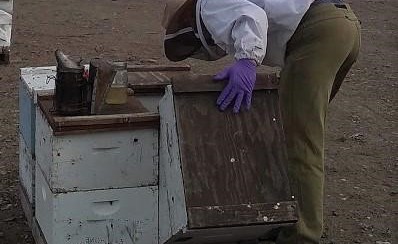Separating a hive from the bottom board and tilting it forward is a useful first step before proceeding further with a colony inspections for several reasons. A tilt allows you to assess the overall weight of a hive while letting the bottom board carry the weight. Tilting also facilitates looking at the bottom bars to assess the coverage and density of bees allowing for a population estimate to be made. These are both valuable pieces of information that allow broad inferences about colony health to be made, but tilting the hive forward before proceeding further also allows you to examine the state of the bottom board for more clues about colony health and specific stressors.

Debris falls to the floor of a hive during the course of normal activity. A strong and healthy colony will remove this debris from the colony and maintain a fairly clean bottom board. If you see an abundance of debris during inspection, it may indicate the colony is small or stressed and unable to keep up with ejecting the debris.



The bottom board collects whatever falls on it, and the bees get rid of it the best they can. While a healthy colony is able to eject most of what collects by dragging it out the entrance, one thing they can’t remove in this manner is water. Rainfall and snowmelt coming down the hive sides and onto the landing board can pool on the bottom board. If not remedied, this accumulation of water can lead to persistent cool and damp conditions in the hive, facilitate mold growth, and decrease the lifespan of woodware. This accumulation of water in individual hives can be easily prevented by ensuring that the entrance of the hive is pointed slightly downhill. It doesn’t need to be much; a ½ inch difference between front and back should be plenty to ensure water flows forward off the landing board instead of backwards into the hive.
While tilting a hive is a simple solution for single hives, this option is not available to beekeepers utilizing pallets as any hives pointing downhill would result in an equal number of colonies pointing uphill on the opposite side of a pallet. Flat, even ground is desirable for setting out large yards in commercial operations, but no one I’ve come across sets their pallets down using a level… it’s inevitable some colonies are going to end up with a slightly upward (fraction of an inch) facing entrances.

To combat the inevitability of water flowing onto some bottom boards, pallets can be designed with some small gaps in the back rim or with holes in the bottom boards to permit water to escape.


